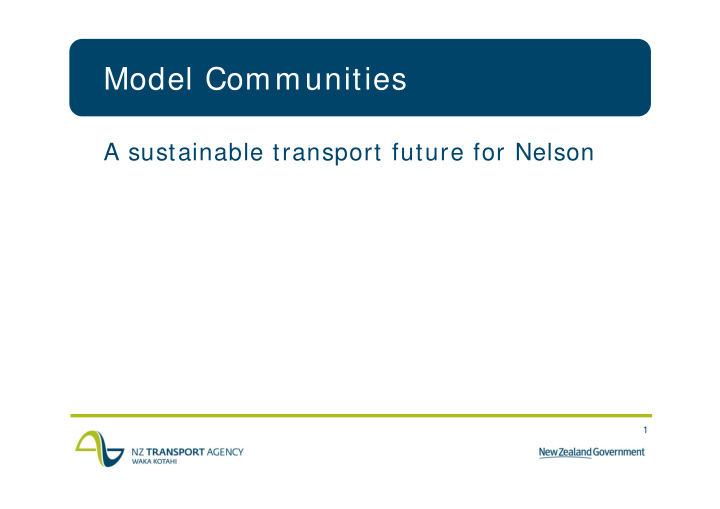



Model Communities A sustainable transport future for Nelson 1
MC Objectives Prim ary outcom e: • To deliver walking and cycling environments that make either walking or cycling the easiest transport choice for the community • Focussed investment that will deliver a successful model community/ s • More people walking and cycling 2
Infrastructure • Making the easiest trip on foot or by bicycle. • Recognising different user skills and providing accordingly • Reinforcing messages • Range of infrastructure 3
• Regional Land Transport Strategy • Sustainability Policy • Cycling & Pedestrian Strategies • Land Development Manual • Heart of Nelson • Residential Subdivision Policy • Regional Physical Activity Strategy 4
Residents Survey (transport) • 79% drive to work • 11% walk or cycled (12% in 06 census) • Satisfaction with work done to improve cycle-lanes, street lighting, footpaths and walkways. 5
Our Application • Our community is motivated. Lots of support from the community. • Much of the plan is about removing the physical barriers by improving infrastructure. • Community programmes include opportunities to upskill people and promote walking and cycling options. 6
7 Infrastructure - Walking
8 Infrastructure - Walking
9 Infrastructure - Walking
10 Infrastructure - Cycling
11 Infrastructure - Cycling
12 Infrastructure - Cycling
13 Infrastructure - Cycling
14 Infrastructure - complimentary
15 Infrastructure - complimentary
Longer term focus on creating dedicated radial routes • Greenways • Green highway • Cycle boulevards • Pedestrian boulevards • Shared space (homezones, woonerven) 16
Removing barriers • Connecting up routes. • Links through CBD. • Links through Rutherford Park. • Safer routes. 17
Ciclovia- http: / / www.streetfilms.org/ ciclovia/ Regular street festivals where streets are returned to public realm • 19
Policies that assist, promote and influence Planning Guidance (NZS draft 4404, maximum car • parking standards, developer contributions, Regional Policy Statement etc) Linkages to other infrastructure programmes • (Maintenance, Safety, etc) RSAPing, community groups and community • programmes Other activities, School speed zones, PT integration, • parking management, traffic calming, road space reallocation, signal timings etc Informed whole of community decision making about • final solutions 20
Getting there • Policies and awareness of policies • Directly related Infrastructure • cycle paths • Indirectly related Infrastructure • shoulder widening • Supporting programmes of work • Safety initiatives • Supporting softer programmes of work • cyclist skills training • The message (enabling access) and profile of W&C 21
Monitoring & Evaluation • Establish how you will measure achievement of the objectives • Specify measures • Identify established methodologies for data collection • Develop methodologies where none exist • Identify data gaps • Establish before and after monitoring programme • Establish reporting and feedback loops for future improvement and learning 22
Monitoring & Evaluation Women and children are the litmus test • Counts (Auto and manual) • Qualitative surveys • Access mapping • Traffic info (speeds, congestion, safety) Total traffic • counts Economic impact statement • Health impact assessment • Community surveys • Safety impacts • Traffic impacts • Benchmarking tool • 23
Stage 2 proposal Funding contributions & expectations • Board expectation – partnership • A community willing to invest • 50–50 contribution to inputs • Focussed investment – network / strategic • Clearly demonstrate the impacts of this investment • $2m in 2010/ 11 & $5m in 2011/ 12 (some flexibility) 24
Stage 2 proposal • Needs to clearly demonstrate proposed programme of activity will deliver successful MC outcomes • Walking and cycling activity class investment sought • Programmes that will support infrastructure (DMCP) • Other activity class investment • Other council funding and activity • Other partnering and funding opportunities • Stage 1 may well address many of these points 25
Time line • Proposals submitted into LTP on-line by end of April • May – proposals assessed • June – proposals and recommendations presented to Board for approval 26
Recommend
More recommend